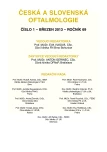Clinical Findings in Members of a Czech Family with Retinitis Pigmentosa Caused by the c.2426_2427delAG Mutation in RPGR
Authors:
B. Kousal; P. Skalická 1; P. Diblík 1; P. Kuthan; H. Langrová 1; P. Lišková 2 1,3
Authors‘ workplace:
Oční klinika, 1. lékařská fakulta, Univerzita Karlova v Praze a Všeobecná fakultní nemocnice v Praze, přednosta doc. MUDr. Bohdana Kalvodová, CSc.
1; Oční klinika, Lékařská fakulta v Hradci Králové, Univerzita Karlova v Praze, přednosta prof. MUDr. Pavel Rozsíval, CSc., FEBO
2; Laboratoř biologie a patologie oka, Ústav dědičných metabolických poruch, 1. lékařská fakulta, Univerzita Karlova v Praze a Všeobecná fakultní nemocnice v Praze, přednosta prof. MUDr. Viktor Kožich, CSc.
3
Published in:
Čes. a slov. Oftal., 69, 2013, No. 1, p. 8-15
Category:
Original Article
Overview
Purpose:
To describe the phenotype of members of the first Czech retinitis pigmentosa family with an identified molecular genetic cause (c.2426_2427delAG in RPGR), followed for more than 13 years.
Methods:
Medical records were reviewed and a detailed ophthalmic examination including spectral-domain optical coherence tomography and full-field and multifocal electroretinography (ERG) was performed in two affected males, three female carriers and one unaffected female.
Results:
A 22-year-old male who denied suffering from nyctalopia had a best corrected visual acuity (BCVA) of 0.63 in both eyes. Moderate myopia and myopic astigmatism were present bilaterally. Color vision and contrast sensitivity were normal. There was an eccentric constriction of the visual fields that spared the central 20 degrees in both eyes. Fundus examination revealed bilateral pigmentary changes in the mid-periphery. Full-field ERG documented a 10% rod and 20% cone response. The phenotype of his cousin, also aged 22 years, was more severe. He complained of nyctalopia since 12 years of age. His BCVA was 0.3 in the right eye and 0.5 in the left eye. Myopia and astigmatism were present bilaterally. Contrast sensitivity and color vision were severely impaired. Full field ERG was extinct, but some activity on multifocal ERG was still detectable. The constriction of the visual fields reached 5 degrees in both eyes. Fundus examination showed the typical retinitis pigmentosa appearance. All carriers denied that they suffered from nyctalopia, but two of them had decreased BCVA in at least one eye. None exhibited typical bone spicules or a tapetal-like reflex. Significant refractive errors were present in all eyes of the carriers.
Conclusion:
The finding of moderate or high myopia and astigmatism in males with retinitis pigmentosa as well as refractive errors in female relatives indicates possible X-linked inheritance, which may be especially important in pedigrees where the transmission pattern can not be clearly established. Our study highlights the inter-individual variability in phenotype observed in similar aged patients with identical ORF15 RPGR mutations.
Key words:
retinitis pigmentosa, phenotype, multifocal ERG, mutation, RPGR
Sources
1. Adamian, M., Pawlyk, BS., Hong, DH., et al.: Rod and cone opsin mislocalization in an autopsy eye from a carrier of X-linked retinitis pigmentosa with a Gly436Asp mutation in the RPGR gene. Am J Ophthalmol. 2006; 142: 515–8.
2. Ayyagari, R., Demirci, FY., Liu, J., et al.: X-linked recessive atrophic macular degeneration from RPGR mutation. Genomics. 2002; 80: 166–71.
3. Bader, I., Brandau, O., Achatz, H., et al.: X-linked retinitis pigmentosa: RPGR mutations in most families with definite X linkage and clustering of mutations in a short sequence stretch of exon ORF15. Invest Ophthalmol Vis Sci. 2003; 44: 1458–63.
4. Beltran, WA., Cideciyan, AV., Lewin, AS., et al.: Gene therapy rescues photoreceptor blindness in dogs and paves the way for treating human X-linked retinitis pigmentosa. Proc Natl Acad Sci U S A. 2012; 109: 2132–7.
5. Berendschot, TT., DeLint, PJ., van Norren, D.: Origin of tapetal-like reflexes in carriers of X-linked retinitis pigmentosa. Invest Ophthalmol Vis Sci. 1996; 37: 2716–23.
6. Berger, W., Kloeckener-Gruissem, B., Neidhardt, J.: The molecular basis of human retinal and vitreoretinal diseases. Prog Retin Eye Res. 2010; 29: 335–75.
7. Breuer, DK., Yashar, BM., Filippova, E., et al.: A comprehensive mutation analysis of RP2 and RPGR in a North American cohort of families with X-linked retinitis pigmentosa. Am J Hum Genet. 2002; 70: 1545–54.
8. Daiger, SP., Bowne, SJ., Sullivan, LS.: Perspective on genes and mutations causing retinitis pigmentosa. Arch Ophthalmol. 2007; 125: 151–8.
9. Demirci, FY., Rigatti, BW., Wen, G., et al.: X-linked cone-rod dystrophy (locus COD1): identification of mutations in RPGR exon ORF15. Am J Hum Genet. 2002; 70: 1049–53.
10. Ebenezer, ND., Michaelides, M., Jenkins, SA., et al.: Identification of novel RPGR ORF15 mutations in X-linked progressive cone-rod dystrophy (XLCORD) families. Invest Ophthalmol Vis Sci. 2005; 46: 1891–8.
11. Fahim, AT., Bowne, SJ., Sullivan, LS., et al.: Allelic heterogeneity and genetic modifier loci contribute to clinical variation in males with X-linked retinitis pigmentosa due to RPGR mutations. PLoS One. 2011; 6: e23021.
12. Fiorentino, F., Magli, MC., Podini, D., et al.: The minisequencing method: an alternative strategy for preimplantation genetic diagnosis of single gene disorders. Mol Hum Reprod. 2003; 9: 399–410.
13. Fishman, GA., Farber, MD., Derlacki, DJ.: X-linked retinitis pigmentosa. Profile of clinical findings. Arch Ophthalmol. 1988; 106: 369–75.
14. Fishman, GA., Weinberg, AB., McMahon, TT.: X-linked recessive retinitis pigmentosa. Clinical characteristics of carriers. Arch Ophthalmol. 1986; 104: 1329–35.
15. Flaxel, CJ., Jay, M., Thiselton, DL., et al.: Difference between RP2 and RP3 phenotypes in X linked retinitis pigmentosa. Br J Ophthalmol. 1999; 83: 1144–8.
16. Garcia-Hoy
Labels
OphthalmologyArticle was published in
Czech and Slovak Ophthalmology

2013 Issue 1
Most read in this issue
- Clinical Findings in Members of a Czech Family with Retinitis Pigmentosa Caused by the c.2426_2427delAG Mutation in RPGR
- Bilateral Neuroretinitis as an Ocular Manifestation of Cat Scratch Disease in 9-year-old Boy. A Case Report
- Retinitis Pigmentosa Mimicking Uveitis. A Case Report
- Simple Binocular Vision Evaluation on Healthy Adult Subjects with Synoptophore
